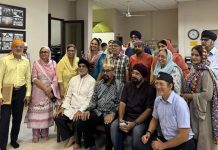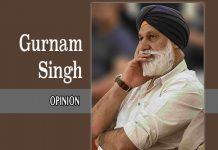| Obed Pasha | Opinion | 15 March 2016 | Asia Samachar |
Rabindranath Tagore was once asked why he got the Nobel Prize for literature and Allama Iqbal did not. Tagore replied: “Probably because I write in my mother tongue and Iqbal doesn’t.”
With this answer Tagore touched on two important points. First, that people can best express themselves through the language they are raised with. And second, that the Muslim Punjabi intelligentsia is apathetic toward Punjabi as a medium of expression.
Language is probably the most important component of social identity for humans. Particularly in the Indian Subcontinent, regional languages play a major role in defining individual and collective identities. As a rule, states and regions tend to be protective of their languages and use them as a political.
Pakistani Punjab, however, presents a curious anomaly as the Punjabi language is systematically suppressed in favour of Urdu. Punjabi is discouraged in education, politics, and government affairs, while all efforts are made to use the most refined Urdu in these domains. Educated Punjabis prefer not to use Punjabi with their children and the language is now reserved only for lewd songs, humour, and anger. Punjabi, however, thrives as the premier medium of communication among the poor masses, while the elites use Urdu to project their differences with masses.
SEE ALSO: Sikhs should fund efforts to preserve heritage sites in Pakistan
SEE ALSO: Punjabi now third language in the Canadian parliament
In the Indian Punjab, on the other hand, Punjabi thrives as an official state language taught in schools and used for government purposes. The use of Gurmukhi is promoted throughout the state of Punjab and the Punjabi elites do not feel ashamed of using their language with their children.
We will have to go back a few centuries to understand the root causes behind this unfortunate treatment toward Punjabi by the Muslim Punjabi elites. After gaining control over his empire, the Mughal king Akbar engaged in a series of wars with the rulers of Gawalior, Ajmer, Rajhasthan, and Gujrat among others to expand his dominions. These costly wars were funded (in part) through aggressive and unfair taxes imposed on Punjabi farmers, which forced the peasants took up arms against Delhi – with Dulla Bhatti as their leader.
These guerrilla wars later continued under successive Sikh gurus and leaders until Ranjit Singh assumed power over Punjab in the early 19th century. With the natives hostile to the Mughals, the Delhi kings had to rely on governors, generals, and administrators from the centre. These included non-native Muslim Persian speaking men like Mirza Nizamuddin, Wazir Khan, and Zakariya Khan, along with numerous others who held power at local levels.
The foreign rulers of Punjab helped develop an elite culture where Punjabi was seen a language for the peasants and the uncultured. So strong was their influence that even Maharaja Ranjit Singh declared Persian as his court’s language although he was a leader of Punjabi speaking peasants. Under the British rule, Persian was gradually replaced by Urdu as the language of the elites and instruction. It is argued that this tradition continues till date and educated Punjabis see Urdu as a language of high culture and Punjabi as a language reserved for commoners.
Other non-Punjabi sub-nationalities in Pakistan, however, view this phenomenon from a socio-political perspective based in current realities rather than history. The smaller provinces suspect Punjab of using Urdu as a political tool to steal their resources. These regions are not only rich in natural resources, they also provide Punjab with access to Afghanistan, Iran, China, and the Indian Ocean. There is a feeling that Punjab is trying to impose Urdu throughout the country to weaken regional identities such that they become willing to share their resources with the federation which is controlled by Punjab.
In India we have seen similar movements against Hindi in Maharashtra, Tamil Nadu, and (ironically) Indian Punjab. Contrary to its Pakistani counterpart, Indian Punjab is a minority state in India and feels pressure from the centre to conform to the mainstream Indian identity. As a result, Punjabis in India are more defensive about their culture, religion, and language. While there is a dearth of contemporary Punjabi literature in Pakistan, there are many such writers across the border. Similarly, there are dozens of Punjabi language newspapers in India and none for the 100 million Punjabis in Pakistan.
The unfair treatment toward the Punjabi language in Pakistan is bothersome at many levels. First, the state of Pakistan is giving a message to the Punjabi masses that their language and culture is not important enough to be taught in schools – that they should learn a non-native language to prosper socially and economically. I wonder how we can expect the masses to feel integrated within the larger society when the state is not prepared to communicate with them in their own language.
Second, instead of unifying the federating units, the imposition of Urdu is contributing to the suspicions smaller provinces hold against Punjab. We have already witnessed a result of this policy in 1971. Bengalis started their struggle on the question of language, which later grew into an independence movement against Pakistan. Instead of an insecure federation enforcing uniformity, Pakistan needs strong sub-regions that are confident of their identity and embrace diversity.
This takes us to the third problem of weakening identity. Since languages are an important source of social identity, subsequent generations of Punjabis unaware of their language will dilute cultural and regional ties. There is a high chance that young people, having lost touch with the pluralistic ideas enshrined in Punjabi language and culture, will end up adopting reactionary ultra-nationalistic or religious extremist identities in their search of an alternate identity. Besides, Punjabi is one of the most widely spoken languages in the world with a history, literature, poetry, songs, and diversity that should make anyone proud.
Fortunately enough, there is a growing realization among the Pakistani Punjabi intelligentsia on this issue. Punjabi intellectuals like Dr Manzoor Ejaz and Afzal Sahir are promoting the Punjabi cause through YouTube videos and radio shows. Although still a long way from mainstream media attention, this reflects a growing confidence among Punjabis for their regional identity. Hopefully one day Punjab will re-embrace its cultural icons like Ashique Hussain Jatt and heroes such as Dulla Bhatti, Ranjit Singh, Rai Ahmed Khan Kharal, and Bhagat Singh. That day, the federation of Pakistan will be stronger than ever.
[An earlier version of this article, entitled Embracing Punjabi, appeared in the Pakistan newspaper The News International on 4 June 2015. See here.]
Obed Pasha is a lecturer of Public Policy at the University of Massachusetts, U.S. He has been fascinating by Punjabi literature and music for as long as he can remember. He is fascinated by figures like Dulla Bhatti, Rai Ahmad Khan Kharal, and Bhagat Singh who fought imperialism like more than anyone else in the sub-continent.
[ASIA SAMACHAR is an online newspaper for Sikhs in Southeast Asia and surrounding countries. We have a Facebook page, do give it a LIKE. Follow us on Twitter. Visit our website: www.asiasamachar.com]
RELATED STORIES:
Sikhs should fund efforts to preserve heritage sites in Pakistan (Asia Samachar, 23 Jan 2016)
3,000 students begin Punjabi classes at 47 centres in Malaysia (Asia Samachar, 10 Jan 2016)
Punjabi now third language in the Canadian parliament (Asia Samachar, 3 Nov 2015)
Canada politics changed forever from personal to community perspective (Asia Samachar, 30 Oct 2015)
Canadistan goes red, liberal (Asia Samachar, 21 Oct 2015)
5 Sikh women, 5 turbaned Sikhs among 19 Indo-Canadians elected MPs (Asia Samachar, 21 Oct 2015)
Amardeep journeys deep into Pakistan in search of Sikh legacy (Asia Samachar, 21 Sept 2015)
Punjabis learn their language their own way – BERNAMA (Asia Samachar, 23 April 2015)
A New Challenge For Punjabi – SIKHCHIC (Asia Samachar, 2 Apr 2015)
Giving voice to Punjabi language (Asia Samachar, 2 Apr 2015)
42 teams in 24th annual Punjabi language carnival (Asia Samachar, 2 Mar 2015)
































